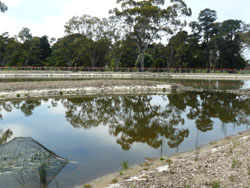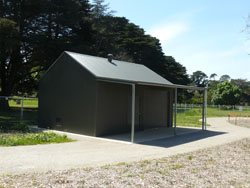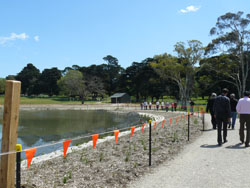resource library
Array
New planting in place - October 2012

Equipment shed needed to comply with heritage controls and have a pitched roof and be iron clad

Pathway runs around lake and temporary fence in place while planting establishes
Eastern Park Stormwater Harvesting
City of Greater Geelong
Published: 05 September 2012
Project Overview
The Geelong Botanic Gardens are located in Eastern Park, Geelong. The Park and Gardens cover a combined area of 80 ha with frontage to Corio Bay. The Botanic Gardens are an important natural and cultural resource for the community. The City of Greater Geelong through its Sustainable Water Use Plan identified the Botanic Gardens as one of the top 10 users of potable water in the city. To reduce the Botanic Gardens’ reliance on potable water for irrigation, a stormwater harvesting project was initiated.
Stormwater runoff draining from a 47 hectare suburban area in East Geelong has now been diverted into the new storage dam within Eastern Park instead of flowing, untreated, out to Corio Bay. The new storage dam has replaced a 7000m2 sporting oval (historically a manmade lake) adjacent to the Gardens. The dam will hold up to 4ML of water and has the potential to provide 90% of the 30ML of potable water used in the Botanic Gardens each year. Water treatment measures incorporated into the design include;
- A Spel Stormceptor Gross Pollutant Trap and rock-filled sediment pond capture all litter down to 5mm in size, as well as suspended solids, light liquids and some of the nutrient load before the water enters the storage basin.
- Further nutrients and toxins will be removed by 10,000 aquatic plants growing around the perimeter of the basin.
- Before use, the stormwater is drawn from a pump well through 3 ‘NextSand’ media vessels receiving 5 micron filtration and then through a UV disinfection unit to achieve the required 1.5 log reduction of virus.
The water is pushed up to a holding tank before being distributed for irrigation at the Geelong Botanic Gardens or to a stand pipe for tree watering.
Drivers and Objectives
- The overriding objective was to reduce the Botanic Gardens reliance on potable water and allow the use of ‘fit for purpose’ water to irrigate the gardens and support tree establishment.
- Underlying objectives included:
- improving the quality and reducing the quantity of stormwater discharge into Corio Bay.
- engaging with the community and raising awareness of the benefits of the project.
Organisations
City of Greater Geelong (Responsible Council)
Australian Government - Water for the Future (Funding Partner)
Spiire - Design Consultants
Project Outcomes
- The project will save up to 30 ML of potable water each year.
- The impact of stormwater runoff on Corio Bay is minimised by:
- Reduced flows
- Reduced pollutant load and concentration entering Corio Bay
- The water storage dam will provide additional benefits of flora and fauna biodiversity in the area, adding to the visual amenity of the area.
- A number of community engagement activities were delivered to raise awareness and promote the benefits of the project. Ongoing updates were communicated to the broad community through on-site interpretive signage, web updates and media releases.
- Enhanced community wellbeing and amenity through the provision of a walking path around the dam which will connect to the Eastern Park Circuit pathway and promote recreation.
Key outcomes will be shared through the Geelong Botanic Gardens Public Programs Strategy which engages the community, schools and industry
Lessons Learnt
- Plan your community engagement activities in advance - the benefits of this project were communicated to the broad community on an on-going basis through on-site interpretive signage, web updates and media releases.
- Think about opportunities for dual purpose amenities - the structure built to house the water treatment and pumping station doubles as a shelter for visitors with a veranda and a seating area.
- Ensure you minimise the risk of people falling into the basin - the slope of the edge of this basin was designed to Royal Surf Lifesavings Guidelines and the new plants will create a physical barrier.
- Consider visual amenity – Except in the case of a sustained dry period, the system is designed to draw down only the top metre of stored water for harvesting.
- Try to retain existing natural assets - Conducting a site research and an impact assessment on existing flora and fauna and heritage values helped inform the best location for the storage basin. As a result no trees were removed and the dam was positioned to be framed by an arc of mature River Red Gums.
- With open water bodies, try to reduce the potential for mosquitos - the system will replenish frequently (up to 20 times per year) and most of the water in the dam is too deep for mosquito breeding.
Project Cost
Total cost - $930,000
Water for the Future contribution - $415,000
City of Greater Geelong contribution - $515,000
Timeframe
Summer 2011-March 2012 - civil construction, erection of shed, installation of pump and treatment equipment
June - Sept/Oct 2012 - planting of the 35,000 terrestrial and aquatic stock
September 2012 - commissioning of stand pipe
November 2012 - connection to new GBG tank
Contact
Anne Miller - City of Greater Geelong P: (03) 5272 4565 E: amiller@geelongcity.gov.au
